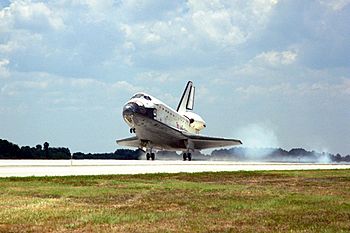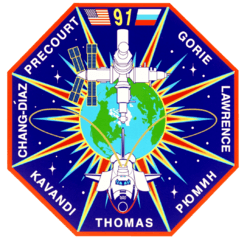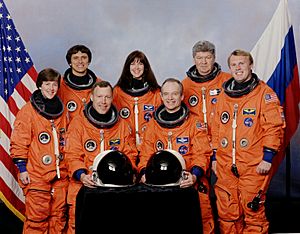STS-91 facts for kids

Discovery lands at Kennedy, concluding the last mission in the Shuttle–Mir program
|
|
| Mission type | Shuttle-Mir |
|---|---|
| Operator | NASA |
| Mission duration | 9 days, 19 hours, 54 minutes, 2 seconds |
| Spacecraft properties | |
| Spacecraft | Space Shuttle Discovery |
| Landing mass | 117,861 kilograms (259,839 lb) |
| Payload mass | 16,537 kilograms (36,458 lb) |
| Crew | |
| Crew size | 6 up 7 down |
| Members |
|
| Landing | |
| Start of mission | |
| Launch date | 2 June 1998, 22:06:24 UTC |
| Launch site | Kennedy LC-39A |
| End of mission | |
| Landing date | 12 June 1998, 18:00:18 UTC |
| Landing site | Kennedy SLF Runway 15 |
| Orbital parameters | |
| Reference system | Geocentric |
| Regime | Low Earth |
| Perigee | 350 kilometres (220 mi) |
| Apogee | 373 kilometres (232 mi) |
| Inclination | 51.7 degrees |
| Period | 91.8 min |
| Docking with Mir | |
| Docking port | SO starboard |
| Docking date | 4 June 1998, 16:58 UTC |
| Undocking date | 8 June 1998, 16:01 UTC |
| Time docked | 3 days, 23 hours, 3 minutes |
  Left to right – Front: Gorie, Precourt; Back: Lawrence, Chang-Diaz, Kavandi, Ryumin, Thomas |
|
STS-91 was a special space mission that marked the very last time a Space Shuttle visited the Russian Mir space station. The mission was flown by the Space Shuttle Discovery, which launched from Kennedy Space Center, Florida, on June 2, 1998. This mission was a big step in preparing for the International Space Station (ISS), showing how different countries could work together in space.
Contents
Meet the STS-91 Crew
The STS-91 mission had a team of six astronauts who flew up to space. One astronaut, Andrew S. W. Thomas, who had been living on the Mir space station, returned to Earth with them, making it seven astronauts on the way back.
| Position | Launching Astronaut | Landing Astronaut |
|---|---|---|
| Commander | Fourth and last spaceflight |
|
| Pilot | First spaceflight |
|
| Mission Specialist 1 | Sixth spaceflight |
|
| Mission Specialist 2 | Third spaceflight |
|
| Mission Specialist 3 | First spaceflight |
|
| Mission Specialist 4 | Fourth and last spaceflight |
|
| Mission Specialist 5 | None | EO-25 Second spaceflight |
Key Moments of the Mission
STS-91 was the last time a Space Shuttle docked with the Mir space station. This was a very important part of the Phase 1 Program. This program helped the United States keep astronauts in space all the time. It also helped develop new ways of working and new equipment for future international space missions.
A Lighter Fuel Tank for Space
This mission was the first to use a new, lighter external fuel tank. This tank was called the super lightweight external tank (SLWT). It was the same size as older tanks, about 47 meters (154 feet) long and 8 meters (27 feet) wide. However, it was about 3,400 kilograms (7,500 pounds) lighter.
The new tank was made from a special aluminum-lithium metal. Its design was also stronger. These improvements meant the Space Shuttle could carry more weight into space. This extra capacity was very helpful for building the International Space Station later on.
Docking with Mir and Crew Exchange
The Space Shuttle Discovery connected with the Mir space station on June 4, 1998, at 4:01 PM UTC. They were orbiting about 335 kilometers (208 miles) above Earth. A few hours later, the hatches between the two spacecraft opened.
When the hatches opened, astronaut Andy Thomas officially joined the Discovery crew. He had spent 130 days living and working on Mir. This moment completed a total of 907 days that seven different U.S. astronauts had spent on the Russian space station.
Transferring Supplies and Experiments
Over the next four days, the crews of Mir and STS-91 worked together. They moved more than 500 kilograms (1,100 pounds) of water between the two spacecraft. They also exchanged almost 2,130 kilograms (4,700 pounds) of cargo, including experiments and supplies.
Many long-term U.S. experiments from Mir were moved into Discovery. These included studies on how space affects things like crystal growth and tissue engineering. The crews also did experiments to reduce risks for future missions and to learn more about human life in space.
On June 8, the hatches closed, and the two spacecraft separated. This marked the end of the final Shuttle-Mir docking mission. It also finished Phase 1 of the International Space Station program.
Studying the Universe with AMS
STS-91 also carried a special science tool called the Alpha Magnetic Spectrometer (AMS) prototype. This device was designed to search for dark matter and missing matter in the universe. It was turned on early in the mission.
There was a small problem with Discovery's communication system, which usually sends high-speed data and TV signals to Earth. Because of this, the AMS data was recorded on board the Shuttle. The crew found a way to send some data using a different communication system when they were close to ground stations.
Communication Challenges
The communication problem meant that no television signals could be sent from the Space Shuttle during the entire mission. There was also a problem between a Russian ground station and their mission control center. This meant that TV broadcasts from Mir were also not possible, and only audio could be heard on NASA television.
Other Experiments in Space
Besides the main tasks, the Shuttle crew also did other experiments. They tested the orbiter's robotic arm with new electronics and software. This was important for future assembly missions for the ISS.
The Shuttle's cargo bay also held eight small experiments called Get Away Special experiments. Inside the crew cabin, astronauts conducted experiments on combustion (burning), crystal growth, and how radiation affects things in space.


